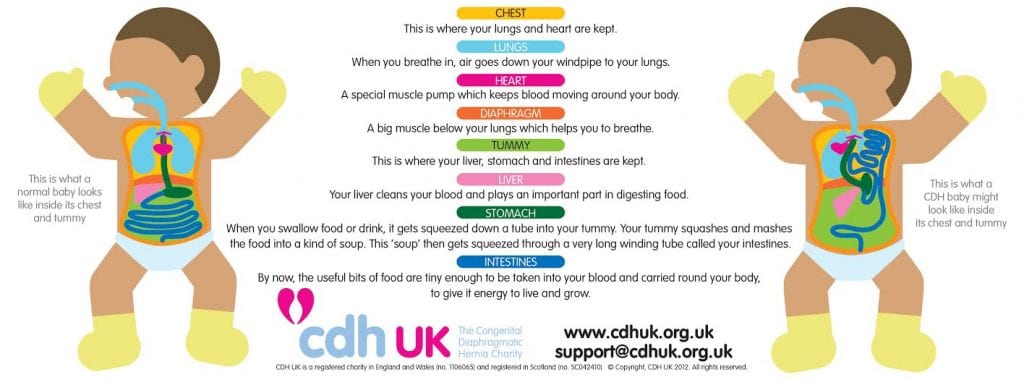- 0800 731 6991
- committee@cdhuk.org.uk
CDH is the shortened name for Congenital Diaphragmatic Hernia. ‘Congenital’ means born with , ‘Diaphragmatic’ means of or affecting the diaphragm (which is a thin sheet of muscle that helps us to breath and keeps our chest and stomach contents separate), ‘Hernia’ is a general term used to describe a ‘bulge’ or ‘protrusion’ of an organ (for example the stomach), through the structure or muscle that usually contains it.
CDH occurs in approximately 1 in 2500 births and accounts for around 8% of all major congenital abnormalities.
There is no firm evidence that it occurs more in one particular sex. However, some studies have suggested that males are more commonly affected than females with 3 boys to every 2 girls diagnosed. Familial clusters (running in families) have been seen in less than 2% of all cases and the risk in future pregnancies is said to be 2%, which means a low chance of it happening again. If CDH is diagnosed as part of a syndrome for example, or there are other organs affected then it may have a higher chance of happening again. There is currently no known single cause or risk factor, but studies have suggested that it is probably multifactorial, meaning there maybe a number of factors involved including environmental and genetic ones.
The diaphragm normally develops in your unborn baby by around the 7-10 week gestation period of your baby’s development and CDH occurs when the diaphragm fails to form correctly or fails to develop in your unborn baby, allowing the abdominal contents to herniate into the chest cavity, which in turn prevents the lungs from developing properly. Depending at what stage the abdominal contents (also referred to as ‘Viscera’) herniate, how much, and the size of the hole in the Diaphragm will determine how much your unborn baby’s lungs and other internal organs, such as the heart, may have been affected.
There are different types of CDH; the most common type is Bochdalek which accounts for over 90% of diaphragmatic hernias and is usually on the left side. Morgagni hernias are less common and are found behind the sternum (breastbone) with most being slightly to the right side. Diaphragmatic eventration occurs when the diaphragm is still intact but is weak and abnormally high in the chest (can be either one one side or both sides). Diaphragmatic Hernias may simply be referred to as a left-sided, right-sided, unilateral (on one side only) or bilateral (both sides).
In a left-sided hernia, varying amounts of abdominal contents can herniate, including small and large bowel, stomach, spleen and sometimes the liver. In right-sided hernias, it is usually only the large bowel and or liver that herniates. Bilateral hernias are uncommon and as the term suggests; affects both sides and pretty much all abdominal contents can move into the chest.
In most cases and particularly in left-sided hernias, the condition is isolated, which means that there are no other associated problems. Rarely, CDH is part of a chromosomal syndrome such as Edward’s Syndrome (Trisomy 18), Patau’s syndrome (Trisomy 13), Down’s Syndrome (Trisomy 21) and Turner Syndrome (Monosomy X). A test during pregnancy is usually offered to test for any Chromosome differences, which will hopefully confirm that the CDH is the only condition to manage. This test involves taking a sample of the fluid around your baby. This test is called an ‘Amniocentesis’. This test unfortunately cannot currently pick up all genetic factors, however once your baby is born you can request Genetic Counselling which may be able to offer further answers if you feel that your baby has other issues . Uncommonly, other syndromes such as Cornelia De Lange and Fryn’s syndrome have also been associated with CDH.
Other features of CDH can include variable degrees of Lung Hypoplasia (incomplete development of the lungs), Pulmonary Hypertension (increased pressure in the pulmonary arteries) and heart defects. These are often difficult to diagnose and confirm to what extent they are present until after your baby is born. Other malformations can occur and are principally the cardiovascular (heart, lungs etc) genitourinary (kidneys, bladder etc) and gastrointestinal systems (stomach, bowel etc).
Currently the prognosis (outlook) for babies diagnosed with CDH remains statistically at 50%, however, some hospitals claim to have a higher survival rate. A measurement called LHR (lung to head size ratio) is often used by Doctors as an indicator to help them to assess the severity of the hernia which can assist them with planning the best management for your baby. This is taken during an ultrasound scan and your Doctor can explain this further to you. As each case is different, each case warrants its own outlook; some babies with extremely good prospects before birth fail to do well and some babies with very little lung and a poor outlook will do extremely well.
